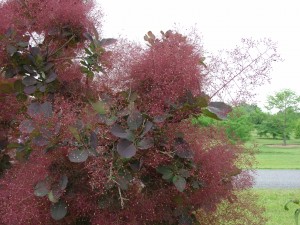“Smokin” may be a corny way to describe the billowy inflorescence (floral head) of common smoketree (Cotinus coggygria). It is native from eastern European to central China. U.S. native, American smoketree (Cotinus obovatus), is far less popular as its inflorescence is much smaller and less showy.
Dusky 6-8 inch diameter ball-shaped inflorescences appear in late May and remain a stunning sight through the month of June in the Southern Appalachian region (USDA hardiness zones 6 and 7).
Common smoketree is grown as a shrub or “smokebush”, but many gardeners eventually wind up shaping it into a multi-trunk small tree. As a small tree it may reach a mature height of 15-20 feet high and 12-15 feet wide, a good fit for most small urban gardens. A young trees or shrubs may start out growing asymmetrical, branched heavily on one side; within a few years the plant grows more symmetrical.
Smoketree grows best out in the open under full sun and in well-drained soils. A young tree establishes quickly, if kept adequately watered during its first two summers. Established trees demonstrate above-average drought tolerance. There are very few serious insect and disease problems that bother smoketree.
Circular spring leaves emerge a rich green, red, or purple color and expand to 1 ½ to 3 inches wide. Foliage of modern cultivars are colorfast and do not fade over the summer. Occasionally, autumn foliage colors are blends of red, orange, yellow, and/ or purple.
Cultivars with purple or burgundy foliage and larger billowy (smoky) inflorescences are in current vogue. Verify the hardiness of your favorite cultivar before planting as some purple-leaved cultivars are questionable.
‘Grace’, a hybrid cross of European and American smoketree is very popular and winter hardy. ‘Nordine’, ‘Royal Purple’ and ‘Velvet Cloak’ are popular purple leaved selections. ‘Golden Ghost’ is a beautiful gold leaf form.
Burgundy and gold leaf cultivars are also grown as foliage perennials. The previous year’s stems are cutback near the ground in late winter to show-off the colorful foliage and are devoid of flowers.


 Posted in
Posted in 
